CLIO Talks Back

Karen Offen
United States
Archive
- Jun 2011
- May 2011
- Apr 2011
- Mar 2011
- Feb 2011
- Jan 2011
- Dec 2010
- Nov 2010
- Oct 2010
- Sep 2010
- May 2010
- Apr 2010
- Mar 2010
- Feb 2010
- Jan 2010
- Nov 2009
- Oct 2009
- Aug 2009
- Jul 2009
- Jun 2009
- May 2009
- Apr 2009
- Mar 2009
- Feb 2009
- Jan 2009
- Dec 2008
- Nov 2008
- Oct 2008
- Sep 2008
- Aug 2008
- Jul 2008
- Jun 2008
- May 2008
- Apr 2008
I.M.O.W.'s debut blog, Clio Talks Back, will change the way you think about women throughout history! Be informed and transformed by Clio Talks Back, written by the museum's resident historian Karen Offen.
Inspired by Clio, the Greek muse of History, and the museum's global online exhibitions Economica and Women, Power and Politics, Karen takes readers on a journey through time and place where women have shaped and changed our world. You will build your repertoire of rare trivia and conversation starters and occasionally hear from guest bloggers including everyone from leading historians in the field to the historical women themselves.
Read the entries, post a comment, and be inspired to create your own legacies to transform our world.
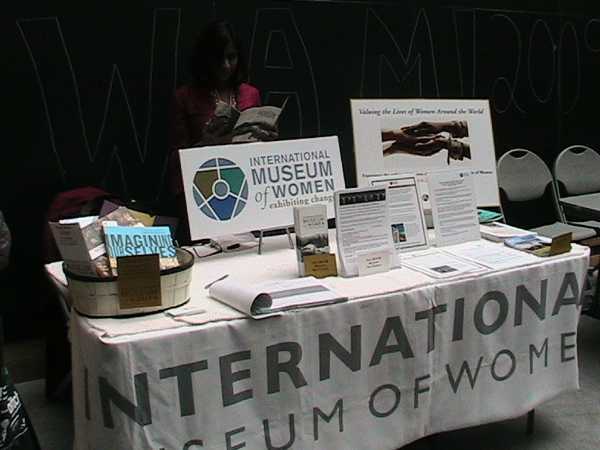
The I.M.O.W. table at WAM! 2009
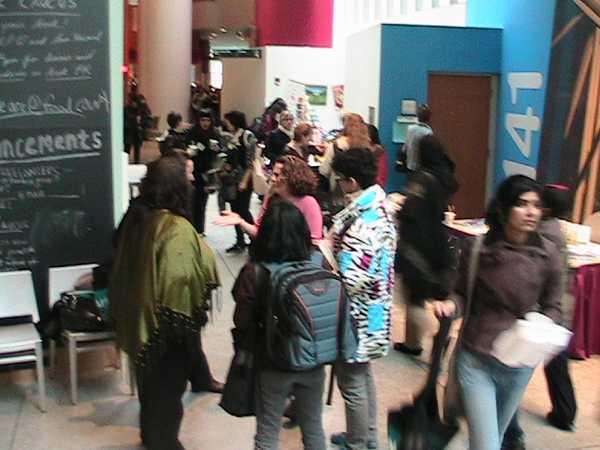
More than 600 journalists, bloggers, artists, producers, scholars, activists, policy advocates and academics gathered at MIT’s Stata Center to exchange ideas and tools for creating change.
I.M.O.W. at WAM! 2009
2009-04-30 00:00:00.000
By Jo Beaton, Manager of Marketing and Communications
In March, curator Masum Momaya and I had the opportunity to travel to Cambridge, Massachusetts for Women, Action and the Media (WAM! 2009), the sixth annual conference for “Journalists, Activists and Everyone” put on by the Center for New Words, an organization dedicated to using “the power and creativity of words to strengthen the voice of progressive women and women speaking from the margins of society.”
At MIT’s Stata Center we were joined by more than 600 independent as well as corporate journalists, bloggers, artists, producers, scholars, activists, academics and other communications mavens to hear and learn about some of the most innovative and cutting-edge work in using media to bring about feminist social change.
I spent the first day in strategy sessions covering all aspects of alternative media outreach campaigns and learning about how best to utilize “digital social capital” such as Twitter and Facebook. I learned firsthand how feminists must permeate all kinds of internet spaces (such as this blog, part of I.M.O.W.’s own online community) to get their messages across. I then set up I.M.O.W.’s exhibition table where those who stopped by got a chance to learn about I.M.O.W.’s toolkit for activists as well as past (http://exhibitions.globalfundforwomen.org/wpp/index), current(http://exhibitions.globalfundforwomen.org/community/stories/index) and future (http://exhibitions.globalfundforwomen.org/exhibitions/index) I.M.O.W. exhibitions. I was especially inspired by the keynote talk on “Women Reporting from the Global Frontlines” by journalists Huda Ahmed from Iraq, Jenny Manrique Cortes from Columbia and Peta Thornycroft from Zimbabwe. Tools and trends in new media are amazing, but nothing can replace the work of talented, committed journalists reporting first-hand from the field.
The nerd in Masum, who is in the process of curating I.M.O.W.’s next exhibition on women and the economy, was tickled by hearing feminist economist Susan Feiner break down how the current tax system in the United States disadvantages women. It’s made her look at all the lines on her own tax forms differently, and is also informing how we think about framing information in the exhibition so it’s useful for visitors.
Amidst the hustle and bustle of the conference, Masum and I convened a strategy session on “Catalyzing Cultural Change with Social Media: Fad or Feminist Fix?” About 70 attended, participated and contributed to a conversation about how to figure out whether Web site platforms and tools are truly contributing to cultural change. Several participants sent tweets from the session and throughout the conference. Experiencing the live blossoming twitter feeds was mind-blowing; many others blogged about the conference, and continue to post and share information on the WAM listserv dedicated to increasing progressive women's influence in the media and the public conversation. Sponsors of WAM! 2009 include Alter-Net, Feministe, Feministing, Bitch, Shameless, Global Fund for Women and many others. Learn more and sign up for info on next year’s conference in Chicago!
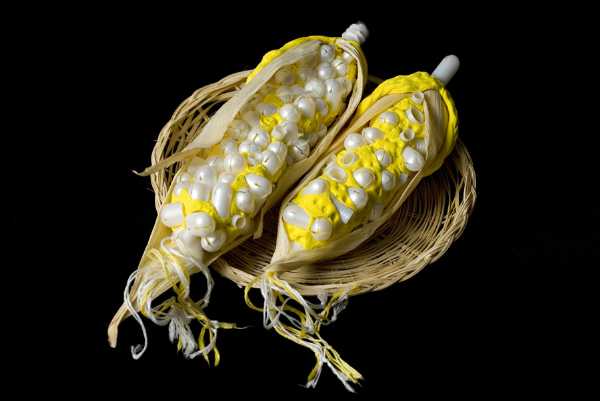
Mariana Castro De Ali's Domestication is one of the most popular art-based stories in "Exhibiting You." Follow in her footsteps, and you will not get lost.
10 Tips for Getting Featured in Exhibiting You
2009-04-22 00:00:00.000
By Sanja Alajbegovic, Editorial Coordinator, I.M.O.W. Exhibitions and Programs
1. First things first: You have to be an I.M.O.W. community member to submit your work for consideration, so begin by registering for our community.
2. No need to reinvent the wheel. Check out the current Exhibiting You stories to see how other artists, activists, journalists and writers are exhibiting their work. Also, don't forget to reference our call for submissions.
3. Please don't spam us. Uploading random jpgs, wav files and press releases is a recipe for rejection. Think before you submit: If you're submitting photographs, choose 5-6 photographs that make up a series or tell a compelling story. If you're submitting art, consider submitting several pieces from a series, not just one. But don't send us everything you've got.
4. What's in a title? Everything. A title can make or break your story. People will "click" on your story only if your title piques their curiosity. So ask yourself: In a list of a dozen titles, will mine stand out?
5. Introductions are golden. Every submission must have a short introduction. Your first sentence should grab our visitors' attention. However, be brief: try not to exceed 100 words.
6. Captions are a must. Without captions, your photograph, art piece, or video might confuse our visitors instead of communicate to them. For example, if you are submitting a video, describe what it's about. The same goes for photographs, art and audio. Engage our visitors. Tell a story. Make them want to click on the play button.
7. Biographical information belongs in your profile. Although your personal history is very important to us, when submitting to Exhibiting You, please describe your work, not your professional background (unless of course, your work is auto-biographical).
8. Personality is always a plus. You don't have to be stuffy. We will not penalize you for not sounding like your art history teacher. We don't want you to. Exhibit yourself by being yourself. Just make sure we understand what you mean.
9. Keep our audience in mind. Our visitors are interested in women's contributions to art, history and culture worldwide. They speak English, Spanish, French and Arabic. Speak to them in clear and compelling ways. If you don't, they might not pay attention.
10. Build your personal profile. Being featured in Exhibiting You, means your work will be seen by 8,000 of our community members. Make sure your profile is complete with information about yourself and your past and current projects. Include links to your Web sites and blogs. You could end up creating many personal connections and professional collaborations through our robust online community.
Good luck and have fun! We look forward to seeing your work!How long have we been fighting the war on poverty ?
2009-04-21 10:43:45.000
Clio has been sorting through her many files. This one struck a chord. People nowadays (at least in the U.S.)tend to think that ?wars on poverty? were invented quite recently, and that women?s disproportionate poverty is relatively new.
Read, then, to the words of Zoé Gatti de Gamond, a Belgian French-speaking ?economic feminist?. Published in 1841-42 in Paris, her book on Charles Fourier and his system laid out arguments that are still relevant in the twenty-first century. Here is what she had to say, nearly 170 years ago:
?The most direct cause of women?s misfortune is poverty ; demanding their freedom means above all demanding reform in the economy of society which will eradicate poverty and give everyone education, a minimum standard of living, and the right to work. It is not only that class called ?women of the people? for whom the major source of all their misfortunes is poverty, but rather women of all classes.
?From that comes the subjection of women, their narrow dependence on men, and their reduction to a negative influence. Men have thus materialized love, perverted the angelic nature of women, and created a being who submits to their caprices, their desires ? a domesticated animal shaped to their pleasures and to their needs. Using their powers, they have split women into the appearance of two classes: for the privileged group, marriage, the care of the household, and maternal love; for the other, the sad role of seduced woman and of the misfortunate one reduced to the last degree of misery and degradation. Everywhere oppression and nowhere liberty.
?The question is not to decide whether it is fitting to give women political rights or to put them on an equal footing with men when it comes to admission to employment. Rather the question exists above all in the question of poverty; and to make women ready to fill political roles, it is poverty above all that must be effaced. Nor can the independence of women be reconciled with the isolation of households, which prevents even the working woman from being independent.
?The system of Fourier, imperceptibly and smoothly introducing associations within society, resolves all the difficulties in the position of women; without changing legislation or proclaiming new rights, it will regenerate them, silence the sources of corruption and reform with one blow education and morals with the single fact that results naturally from the associational principles of his system: a common education and the independence of women assured by the right to work [employment]; independence rendered possible by the association of households, attractive and harmonious work, and the multiplication of wealth.?
Clio asks you: do you think this is a ?utopian? dream or a program for action? What elements can inform our action today?
Source: Zoé Gatti de Gamond, Fourier et son système (Paris: Capelle, 1841-42). pp. 247-66 ff. As translated in Bonnie G. Smith?s text Changing Lives: Women in European History Since 1700 (1989), pp. 174-75.
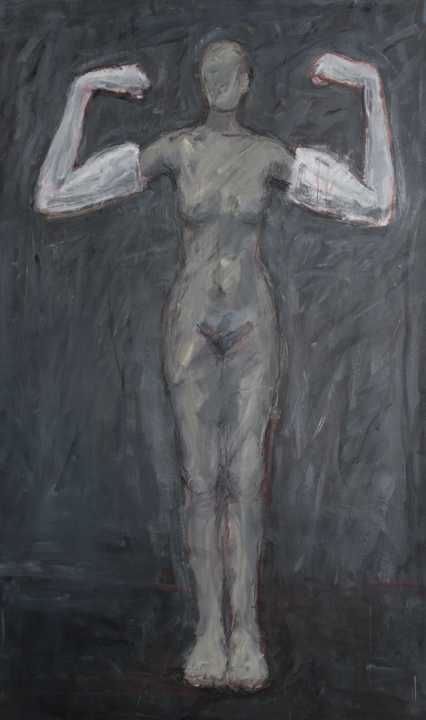
In Strength, only the arms remain of Anki's attempt at painting a male figure.

Vine Woman is a sculpture Anki King made during her stay at the Virginia Center for the Creative Arts. Made of branches and vines, the sculpture was left to live out the rest of its days in the woods, where it, too, will endure the inevitable process of death.
Artist Interview: Anki King
2009-04-21 00:00:00.000
By Morgan Levey, I.M.O.W. exhibitions intern and supporter of women in the arts
"Exhibiting You," I.M.O.W.'s most recent online project, showcases the creative work of women and men from around the world. Hundreds of artists, musicians, journalists and activists have already submitted their work. In this blog we are spotlighting individual artists who have engaged our audience with their submissions. Norwegian artist Anki King is the third person interviewed in this series.
Painter, sculptor and illustrator Anki King uses the human figure to portray relationships, examine identities and come to terms with the prospect of her own death. Her life-sized works are dramatic and seductive, drawing the viewer in with their power and familiarity.
Anki created two submissions for "Exhibiting You": Sisters and Vine Woman. She has also participated in past I.M.O.W. exhibitions; her story Alternative Reality was featured in the "Image and Identity" theme of "Imagining Ourselves."
Originally an economics student, Anki King became a full-time artist she was introduced to oil paints. Expanding her repertoire over the years to include sculpture and installation, Anki creates human bodies using charcoal, oil paint and plaster. Her figures lack facial features and recognizable backgrounds; they are stationary, yet far from lifeless.
By withholding detailed information, Anki gives the viewers space to inject themselves into the canvas. She says, "If everything is described, you only get to see the work once. When things are left more open--not so detailed and not so specific--the work lets the viewers experience it in a different way every time they see it. The artwork gets to express more this way."
About six years ago, Anki's work took a turn inward, as she moved away from painting the outside world in order to examine herself and her relationships. The result is a brutally honest and direct art that comes from deep within.
When I asked if all of her figures were female, she shared this humorous story: "Recently, a class of school kids visited me and asked, 'Do you only paint females?' And that was the first time I realized, I do! After they left, I was determined to paint a male figure. I kept trying and trying, until I finally realized I couldn't. I just couldn't be honest about being a man because I couldn't understand what it felt like to be a man. The result of my attempt is a painting called Strength. I ended up giving up and I painted over him a female figure, except for the arms. She has these large arms, which are the only part left of my failed man."
Although painting and drawing are Anki's main concentrations, she has grown over the years into a talented sculptor. Our "Exhibiting You" audience is familiar with Vine Woman, a ephemeral and slowly disintegrating sculpture made entirely from branches. She too is part of Anki's look inward, for Vine Woman is the artist's way of coping with the natural process of death. She says, "It's scary and sad to talk about death, but I want to accept it as part of life; I don't want to be afraid of it. So I keep working, touching on the subject once in a while in my work, trying to get to know it."
Read the complete interview with Anki King to learn more about the inspiration behind "Sisters" and her "failed man" painting Strength.
Read two more interviews from this series: Caribbean-American curator and artist Orlonda Uffre speaks about Caribbean art and spirituality and Mexican-American artist Mariana Castro De Ali paints migration, both human and bird.
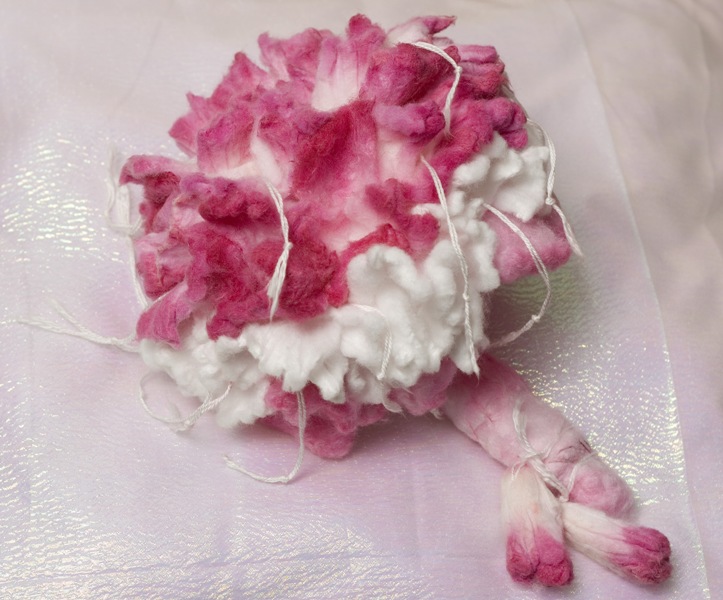
Memories of XV, 2007 | Tampons and thread | 10 x 8 x 5 inches
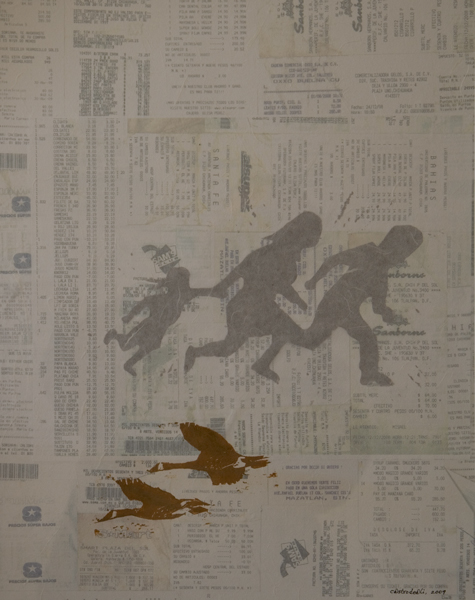
Reverse Migration, 2009 | Linoleum print on sales receipts | 15.5 x 19 inches
Artist Interview: Mariana Castro De Ali
2009-04-13 00:00:00.000
By Morgan Levey, I.M.O.W. exhibitions intern and supporter of women in the arts
"Exhibiting You" is I.M.O.W.'s most recent online project that showcases the creative work of women and men from around the world. Hundreds of artists, musicians, journalists and activists have already submitted their work. In this blog we will be spotlighting individual artists who have engaged our audience with their submissions. This interview with Mariana Castro De Ali, a Mexican-American artist living in the San Francisco Bay Area, is the second interview in this series.
Mariana Castro De Ali is a multimedia artist who gives voice to the needs of minorities, raises awareness about the neglected and expresses her identity by using her art to communicate with the world. Her submissions, Domestication, Tribute and The Flowers That I Lost, were featured in January and February. Domestication was a Museum Pick from January 21 - February 2, 2009.
Originally from Mexico, Mariana immigrated to the United States with her family in the early 1990s. Her work covers issues from gay rights to violence against women. Her will to give a voice to groups of people who are often overlooked comes from her own experience of immigrating to a foreign land where she felt vulnerable and misunderstood.
She describes meeting her future husband the day she arrived in the Bay Area: "I only spoke Spanish at that time. As a result, we used drawings to communicate with each other. I find that words can be a source of misunderstanding; many people misunderstand the point you are trying to express due to the limitation of language. This does not happen with art pieces; instead, people develop their own dialogue or personal connection with art."
Her newest series of work, "A Matter of Survival," focuses on immigration and the obstacles faced by people crossing borders. Using the migratory flight of birds as a metaphor for the movement of people, Mariana says, "Migratory birds and humans share the same experience of fighting for life. People move around in search of a better life."
The significance of Mariana's work goes beyond the social consciousness she inspires, for she makes heavy and sometimes ugly subjects inviting and beautiful. In The Flowers That I Lost, she approaches the subject of amenorrhea -- the absence of menstruation experienced by women suffering from anorexia nervosa -- yet the work is a delicate white canvas with tampon flowers floating on the surface. Her ability to take an object like a tampon, and turn it into beautiful ears of corn, like in Domestication, is the key to her message and why she is so successful. She makes us not want to avoid the complicated and the controversial, but instead lures us into learning more about the struggles of the vulnerable.
Read the interview with Mariana Castro De Ali to learn more about her artwork, relationship with her materials and social consciousness.
Read the first interview in this series with the curator and artist Orlonda Uffre.
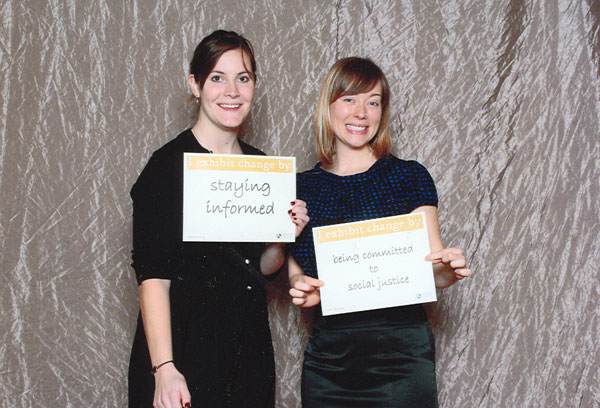
Laura Hannemann, social media intern, and Renee Gasch, online promotions coordinator, pose with their answers to the question "How do you exhibit change?" at the I.M.O.W. 2009 Annual Gala photo booth.
My I.M.O.W. Internship
2009-04-10 00:00:00.000
By Laura Hannemann, I.M.O.W. intern and blog outreach specialist
Several months ago, I was lucky enough to be alerted to the I.M.O.W. internship program by a well-informed friend. I was excited by the opportunity to join I.M.O.W. as an intern because it combined my interests in women's studies, education, and media. The structure of the museum is such that it offers opportunities for engagement in a number of fields including art, museum studies, gender studies, writing, and education.
At any given time, I.M.O.W. has one to seven interns supporting its exhibitions and programs as well as other museum projects. I.M.O.W. interns sign on for at least three months to help research content, solicit artists to participate, and do promotions outreach.
During my internship I focused on social media outreach--specifically, a blog outreach campaign. I compiled a list of bloggers and contacted them to ask if they would write posts about the museum's Women, Power and Politics online exhibition. It is a joy to promote an organization with such an important message, and to have that message so enthusiastically received by the bloggers I was contacting.
I was also lucky enough to work on several other projects, such as launching this blog and establishing a museum presence on the social networking site Twitter. I learned a lot about social media, web 2.0 practices, and general non-profit outreach.
My outreach projects were just one set of opportunities available to I.M.O.W. interns. Next to me sat Morgan, the exhibitions and programs editorial intern, who has a background in art history and is interested in museum studies. In her first month at the museum, she copy edited I.M.O.W.'s entire Women, Power and Politics online exhibition. Morgan has since researched and solicited artists to participate in the Exhibiting You community showcase. Like me, she says that the enthusiasm she has received from participating artists has been truly rewarding and reminded her how important it is to provide a platform for those voices.
My internship ended in March and I.M.O.W. is currently looking for new interns. If you're looking for an internship or a career in nonprofits, arts, education, online media, or women's issues, I would recommend interning at I.M.O.W. I gained invaluable insight into the workings of museums and non-profit organizations in just a few short months. Being part of an office team and managing my own projects has been essential to my career development.
Most importantly, during my time at I.M.O.W., I have found so much inspiration directly through the online exhibition stories and from interacting with the supporters of the museum. If you're interested in becoming an I.M.O.W. intern, click here.
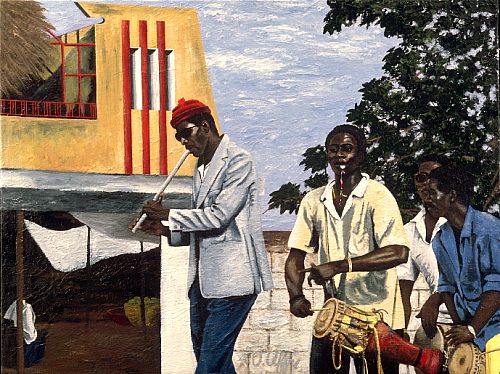
Orlonda Uffre, Prelude, Acrylic on canvas, 32" x 38"
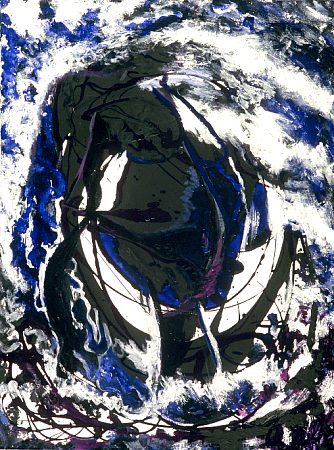
Orlonda Uffre, Beginning, Acrylic on canvas, 32" x 24"
Artist Interview: Orlonda Uffre
2009-04-03 00:00:00.000
By Masha Rotfeld, I.M.O.W. exhibitions intern, who loves finding artists to showcase in "Exhibiting You"
"Exhibiting You" is I.M.O.W.'s most recent online project that showcases the creative work of women and men from around the world. Hundreds of artists, musicians, journalists and activists have already submitted their work. We decided to interview some of them because they particularly engaged and inspired our visitors. Oakland-based Orlonda Uffre is the first artist featured in this series.
Orlonda Uffre is an activist, optimist, teacher and artist. Her painting Now & Then, featured on March 15, 2009, in "Exhibiting You," explores women's experience of colonialism, slavery, migration, rootlessness and modernity.
In the 1970s, Uffre played an important role in the feminist movement and helped found the Women's Interart Center, one of the first women's art centers in the world. Since then she has served as a curator for many arts and culture organizations in the San Francisco Bay Area including the Vida Gallery of the Women's Building and the Sargent Johnson Gallery. She is currently part of the Diaspora Arts Coalition that works to promote and find venues for artists within the African diaspora.
It was an honor to interview her. She explained that she is at odds with the concept of "art for art’s sake" and that she wants to create art that is socially and politically driven: “I tend to create social narratives mainly because I think that much of history has been forgotten. The way I view the world is affected tremendously by the effects of colonialism of the last five hundred years. I think history needs to be acknowledged and documented before we can honestly attempt to eliminate the debilitating vestiges of inequity.”
We also talked about spirituality and the rituals of the syncretic Caribbean religions that play a big role in her art: “Color has religious significance in the Caribbean. Every color refers symbolically to an Orisha. Eleggua, [featured in my painting Prelude] for instance, is an Orisha represented by the colors red and black. He represents the force of nature which makes possible communication with our divine selves and our ancestral origins.”
Read the complete interview with Orlonda Uffre to find out more about her activism and her art that celebrates the African diaspora, her ancestry and the strong women in her family.

